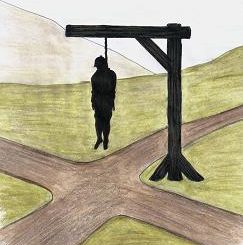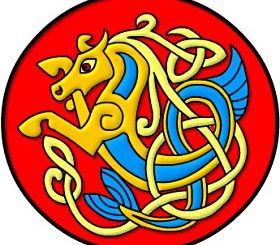Kersal Cell
The Grade II listed Kersal Cell which dates from 1563 is the second oldest building in Salford and was the home of the English poet John Byrom (also known as John Byrom of Kersal and John Byrom of Manchester) (Born 29 February 1692 – Died 26 September 1763).
 The following story concerning Kersal Cell appeared in Lancashire Legends (1873) by John Harland & T T Wilkinson. ‘It is a snug substantial residence, reminding us of Hawthorne’s “House of Seven Gables.” In the “Doctor’s” time, it would be all that a poet could desire. In fixing here his hermitage, hundreds of years ago, its original recluse. Sir Hugh le Biron, showed taste as well as sanctity. He was no “friar of orders grey,” no monk of the fraternity of Black Penitents; but a stalwart knight, once owner of Clayton Hall and Kersal Cell; both of which mansions have since become linked with nobler though untitled names. Tradition asserts that Sir Hugh left Clayton Hall for the Holy Land, with an esquire bearing his shield, and a hundred stout followers in his train. As the knight and retainers marched away, his lady prettily waved her handkerchief from the tower or turret of Clayton Hall. Arrived at the Holy Land, Le Biron dealt out his deadly blows with no niggardly measure, spreading dismay through the ranks of the enemy. Wherever an infidel’s head was visible, there also was the arm of Sir Hugh, ready to cleave it in twain. At length his conscience became troubled, and he began to doubt the righteousness of his righteous cause. The ghosts of those slain by his valour rose in vast numbers before his distempered vision; the wailing of widows and the weeping of orphans, seemed to haunt him where soever he went, until he was glad to escape from the land thus rendered unholy, and turn his steps towards the English home from which he had been too long estranged. As he passed slowly up his own avenue he met a funeral train, bearing the remains of his lady to her final resting-place, there, as the tomb-stone sweetly expresses it, to “sleep in Jesus.” Year after year she had pined for her absent lord, gradually sinking, the victim of “hope deferred.” This blow severed the last link that bound Le Biron to the world, and he retreated from its turmoil to that solitude of Kersal Cell. Here, a “hermit lone,” he alternately prayed and wandered, — climbing the picturesque heights of Kersal, or the wooded ways of Prestwich — until death, remembering the repentant warrior, removed him to the peaceful grave. — Procter’s “Our Turf, Stage, and Ring.”
The following story concerning Kersal Cell appeared in Lancashire Legends (1873) by John Harland & T T Wilkinson. ‘It is a snug substantial residence, reminding us of Hawthorne’s “House of Seven Gables.” In the “Doctor’s” time, it would be all that a poet could desire. In fixing here his hermitage, hundreds of years ago, its original recluse. Sir Hugh le Biron, showed taste as well as sanctity. He was no “friar of orders grey,” no monk of the fraternity of Black Penitents; but a stalwart knight, once owner of Clayton Hall and Kersal Cell; both of which mansions have since become linked with nobler though untitled names. Tradition asserts that Sir Hugh left Clayton Hall for the Holy Land, with an esquire bearing his shield, and a hundred stout followers in his train. As the knight and retainers marched away, his lady prettily waved her handkerchief from the tower or turret of Clayton Hall. Arrived at the Holy Land, Le Biron dealt out his deadly blows with no niggardly measure, spreading dismay through the ranks of the enemy. Wherever an infidel’s head was visible, there also was the arm of Sir Hugh, ready to cleave it in twain. At length his conscience became troubled, and he began to doubt the righteousness of his righteous cause. The ghosts of those slain by his valour rose in vast numbers before his distempered vision; the wailing of widows and the weeping of orphans, seemed to haunt him where soever he went, until he was glad to escape from the land thus rendered unholy, and turn his steps towards the English home from which he had been too long estranged. As he passed slowly up his own avenue he met a funeral train, bearing the remains of his lady to her final resting-place, there, as the tomb-stone sweetly expresses it, to “sleep in Jesus.” Year after year she had pined for her absent lord, gradually sinking, the victim of “hope deferred.” This blow severed the last link that bound Le Biron to the world, and he retreated from its turmoil to that solitude of Kersal Cell. Here, a “hermit lone,” he alternately prayed and wandered, — climbing the picturesque heights of Kersal, or the wooded ways of Prestwich — until death, remembering the repentant warrior, removed him to the peaceful grave. — Procter’s “Our Turf, Stage, and Ring.”
A History of the County of Lancaster: Volume 4 (1911)the following account of the history of Kersal Cell. ‘KERSAL was in 1142 given to the priory of Lenton, and a small cell called St. Leonard’s was established there. On the suppression of monasteries it was in 1540 sold by Henry VIII to Baldwin Willoughby, and some eight years afterwards was sold to Ralph Kenyon, apparently acting for himself and for James Chetham and Richard Siddall.
The Kenyon third descended in that family for some time. It included the cell or monastic buildings. The Siddall third was alienated in 1616 to William Lever of Darcy Lever, and descended to Rawsthorne Lever of Kersal, who died in 1689 without issue, having bequeathed it to the Greenhalghs of Brandlesholme in Bury. This part was purchased by Samuel Clowes in 1775. The Chetham third had already come into the hands of the Clowes family, whose descendants retain their estate in Kersal.
 The Kenyon third was about the year 1660 alienated to the Byroms of Manchester, whose line terminated in the death of Miss Eleanora Atherton on 12 September 1870. It had one famous holder— John Byrom of Kersal, Jacobite, hymn-writer, and shorthand inventor; he was born in 1692, educated at Trinity College, Cambridge, of which he became a fellow, and died at Manchester in 1763. Like the manor of Byrom it was bequeathed to Mr. Edward Fox, who took the name of Byrom.
The Kenyon third was about the year 1660 alienated to the Byroms of Manchester, whose line terminated in the death of Miss Eleanora Atherton on 12 September 1870. It had one famous holder— John Byrom of Kersal, Jacobite, hymn-writer, and shorthand inventor; he was born in 1692, educated at Trinity College, Cambridge, of which he became a fellow, and died at Manchester in 1763. Like the manor of Byrom it was bequeathed to Mr. Edward Fox, who took the name of Byrom.
The house now called Kersal Cell occupies the site of the old religious house. It is a small two-story building of timber and plaster, much altered from time to time, but probably dating from the middle or end of the 16th century. It stands on low ground near a bend of the River Irwell, facing south, with the heights of Broughton and Kersal Moor immediately to the north and east. In more recent times a large brick addition has been made on the north, and extensions have also been made on the east in a style meant to harmonize with the timber front of the older part. The original house, which possibly is only a fragment of a larger building, has a frontage of about 56 ft. and consists of a centre with a projecting wing at each end. The west wing has a bay window in each floor, but the east wing has an eight-light window and entrance doorway on the ground floor and a slightly projecting bay above. Both wings have gables with barge boards and hip knobs, but the timber construction is only real up to the height of the eaves, the black and white work in the gables being paint on plaster. This is also the case with the east end and the whole of the front of the later extension on the same side. The roofs are covered with modern blue slates, and the west end is faced with rough-cast. The general appearance at a distance is picturesque, but at close view the house is too much modernized to be wholly satisfactory, and it is dominated by the brick building on the north, whose roof stands high above that of the older portion.
There is a tradition that Dr. Byrom wrote ‘Christians, Awake’ in Kersal Cell, and that it was first sung in front of the house on Christmas Eve 1750, but both events are more likely to have taken place at Byrom’s house in Manchester.
I came across a comment suggesting that locally Kersal Cell is thought to have had a reputation for being haunted. During the 1970s it was made into a restaurant and country club though later the building was allowed to fall into disrepair, though it may now be split into private residences.




Re: Kersal Cell
A History of the County of Lancaster: Volume 2 (1908)
HOUSE OF CLUNIAC MONKS THE CELL OF KERSAL
In the reign of Stephen Ranulf Gernons, earl of Chester, when in possession of the district ‘between Ribble and Mersey’ gave the hamlet of Kersal in the township of Broughton, parcel of his demesne manor of Salford, to the Cluniac priory of Lenton, near Nottingham, in free alms for the establishment of a place of religion. The gift, the date of which lies between 1143 and 1153, included rights of fishery in the Irwell and of pasture on and approvement of the waste. Ranulf’s tenure of ‘between Ribble and Mersey’ was a mere interlude, and between 1174 and 1176 Henry II regranted Kersal to Lenton Priory without mention of any previous grant. In his charter it is described as a hermitage which the monks of Lenton are to hold as freely and quietly as Hugh de Buron their monk held it. This seems to point to some interruption in their ownership. King John confirmed his father’s grant on 2 April, 1200. Whether Lenton at first kept more than a single monk at Kersal is not quite clear. The papal delegates who, about the date of John’s confirmation, settled a dispute between the monks of Lenton and Albert de Nevill, rector of Manchester, in whose parish Kersal lay, ordered that the ‘prior sive alius qui apud Kersale pro loco custodiendo pro tempore fuerit’ should always promise to observe the rights of the mother church. It is not, however, until the fourteenth century that the existence of a prior of Kersal is definitely attested. From a Cluniac visitation of that date it appears that there were then a prior and one monk in the cell. Mass was celebrated only once a day. The dispute with the rector of Manchester referred to above arose out of the diversion of tithes, offerings, and mortuaries to the chapel and cemetery of the cell. By the settlement arrived at the rector conceded the right of sepulture at Kersal in return for an annual gift of two candles, each of 1½lb. of wax, but no parishioner was to be buried or make offerings there without full compensation to the church at Manchester; the admission of parishioners to the sacraments by the monks was forbidden.
Beyond this, a temporary seizure by the crown, about 1371, on the plea that the original gift bound Lenton to keep two monks there, and one or two grants of land, the history of the cell is a blank. It might have come to an end in the fifteenth century had not Lenton, which as a filiation of Cluny ranked as an alien priory, secured letters of denization from Richard II in 1392-3.
Doctors Legh and Layton in their report confined themselves to the financial condition of the cell. As one of the larger monasteries Lenton escaped dissolution in 1536, but was already being bled. The prior wrote to Cromwell begging time to complete the payment of £100 to him, and adding, ‘I have accomplished your pleasure touching the cell of Kersal in Lancashyre.’ What Cromwell’s pleasure was there is nothing to show.
In April, 1538, Thurstan Tyldesley, hearing that Lenton was about to come into the king’s possession, asked Cromwell to let him have the farm of Kersal, which he said was worth twenty marks a year—a considerably higher estimate than the king’s commissioners had made in 1535-6. The site and demesne lands of the cell, however, were leased by the crown on 3 February, 1539, for twenty-one years to John Wood, ‘one of the Oistryngers,’ at a rent of £11 6s. 8d. On 23 July, 1540, the crown sold the cell to Baldwin Willoughby, sewer of the chamber, for £155 6s. 8d.
Kersal cell was dedicated to St. Leonard. Its original endowment was augmented in the reign of Richard I or John by grants of two parcels of land in the parish of Ashton-under-Lyne; Matthew son of Edith gave a portion of his land in Audenshaw, and Alban of Alt half Paldenlegh. In the new valuation for the tenth, made in 1535, the income of the cell was stated to be £9 6s. 8d., the only deduction mentioned being an annual fee of £1 to the steward, Sir John Byron of Clayton, kt. Legh and Layton speak of a debt of twenty marks. The crown contrived nearly to double the income; the lessee paid £11 6s. 8d., and other rents not included in his lease brought up the total to £17 14s. 10d. (fn. 17)
Prior of Kersal John of Ingleby, occurs March, 1332.